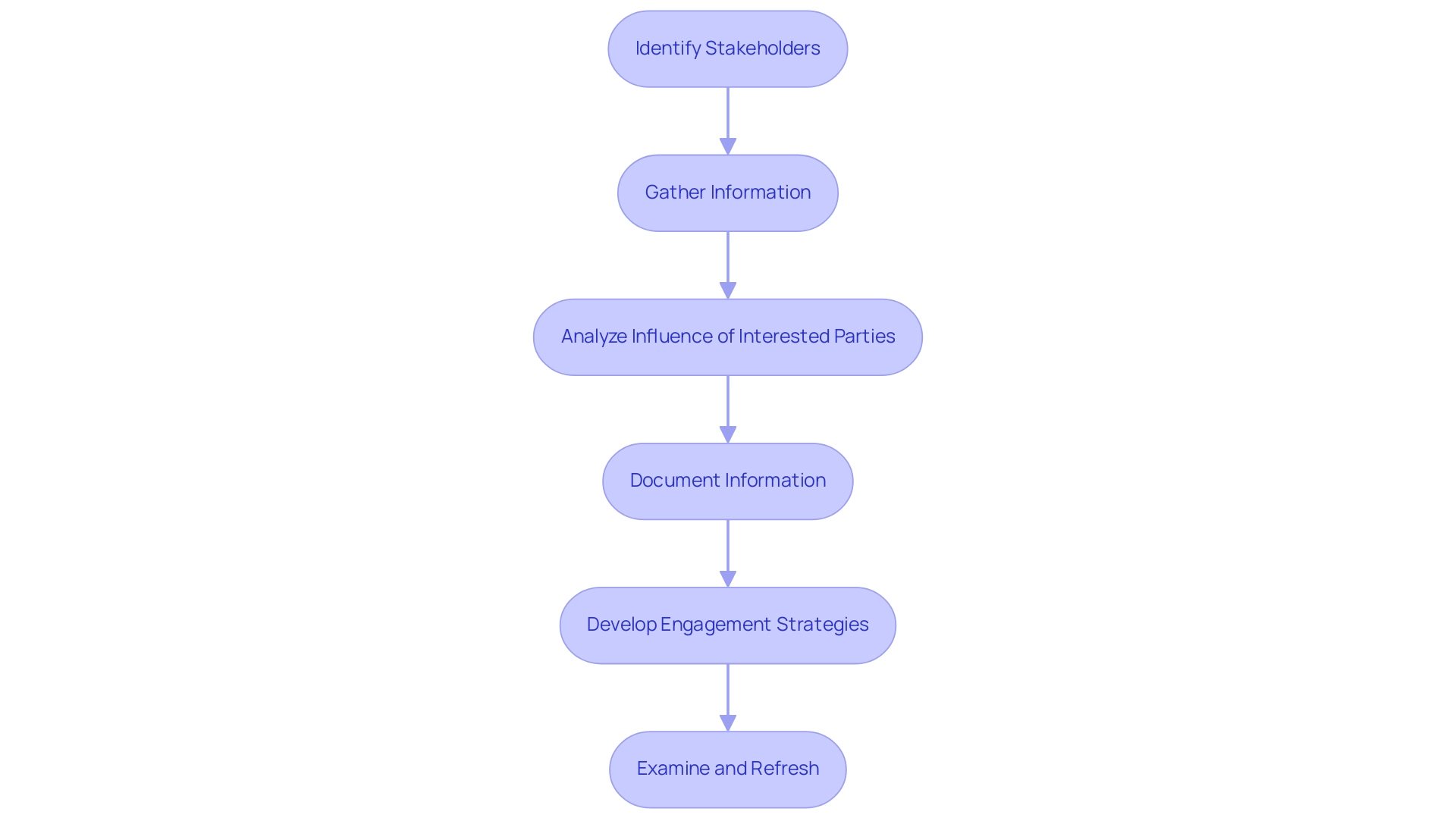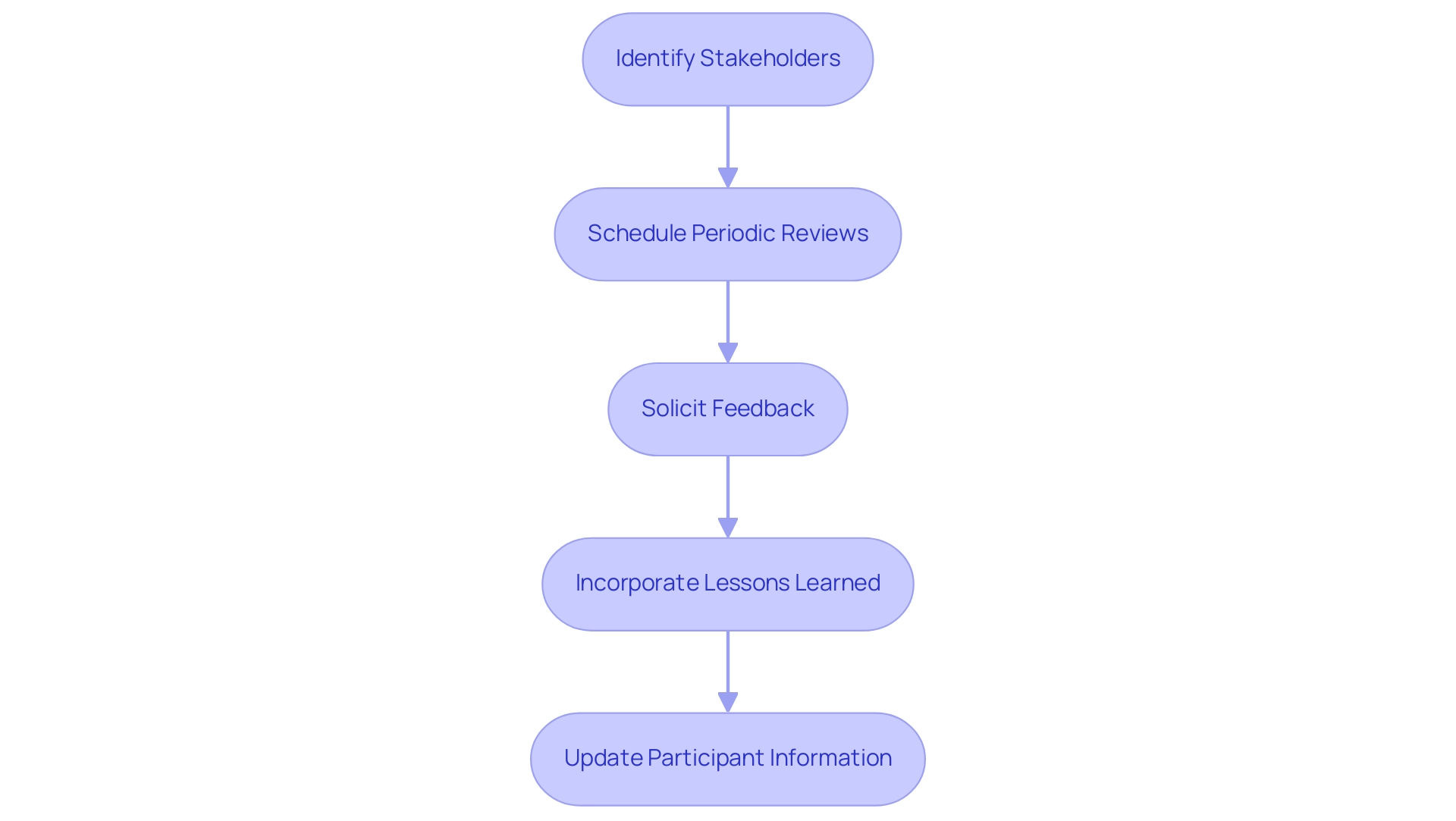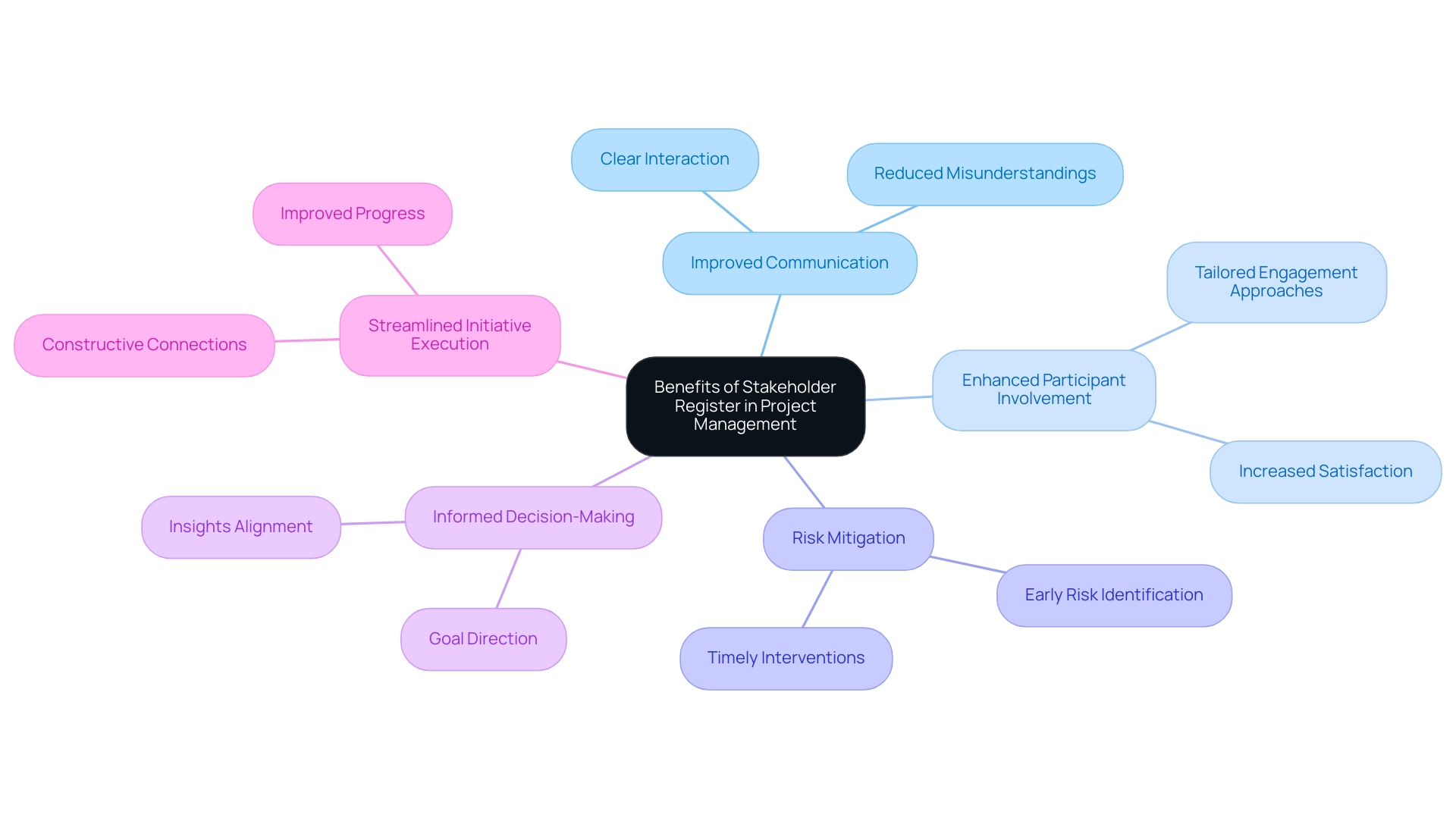Overview
A stakeholder register in project management is a critical tool that systematically identifies and documents individuals, groups, and organizations with interests in a project, facilitating effective communication and engagement strategies. The article emphasizes that maintaining a comprehensive stakeholder register can significantly enhance project success rates by improving communication, mitigating risks, and aligning stakeholder expectations with project objectives, thereby fostering productive relationships and ensuring timely project completion.
Introduction
In the intricate world of project management, the ability to navigate stakeholder dynamics can make or break a project's success. A stakeholder register emerges as a crucial tool, meticulously cataloging individuals and organizations with vested interests, while providing insights into their influence and expectations. As organizations strive to align project goals with stakeholder needs, the importance of this register becomes increasingly evident.
With nearly half of strategic initiatives faltering due to misalignment, effective stakeholder engagement is not just beneficial—it is essential. This article delves into the intricacies of creating, maintaining, and leveraging a stakeholder register, highlighting its pivotal role in fostering communication, mitigating risks, and ultimately driving project success in an ever-evolving landscape.
Defining the Stakeholder Register: An Essential Tool in Project Management
What is a stakeholder register in project management is an essential management tool that systematically identifies and documents individuals, groups, and organizations with a vested interest in an initiative. This register serves as a centralized repository outlining interests, influence, and what is a stakeholder register in project management, detailing the potential effect they may have on results. By clearly identifying involved parties, managers can create customized communication and engagement strategies, ensuring that all relevant individuals are effectively considered throughout the lifecycle.
This foundational understanding is vital, particularly as research shows that nearly half of strategic initiatives fail due to a lack of alignment with business objectives. Successful engagement of interested parties, highlighted by robust connections and communication, is essential for achieving success. In fact, organizations utilizing formal methods for overseeing tasks report that 73% often achieve their objectives, compared to only 58% of those that do not.
Moreover, management expenses vary from 7% to 11% of the overall cost, highlighting the financial consequences of efficient participant involvement. Additionally, with 39% of social media users expecting quick responses, the need for timely engagement strategies becomes increasingly important. This emphasizes what is a stakeholder register in project management, as it highlights the importance of a properly maintained list of interested parties in reaching milestones and ultimately propelling success in 2024 and beyond.
The Purpose and Importance of a Stakeholder Register in Project Success
A participant register functions as an essential resource for maintaining efficient communication and involvement throughout the lifecycle of the initiative. By maintaining what is a stakeholder register in project management, which includes a detailed record of stakeholders such as external entities like clients and internal participants like the team, managers can identify key individuals and groups, gaining a comprehensive understanding of their interests and concerns. This proactive management approach enables the creation of customized strategies that address specific interests, which is essential in minimizing risks linked to miscommunication and conflict.
Significantly, firms that adopt successful engagement strategies are 40% more likely to finish tasks on schedule and within financial limits. This alignment of objectives with participant expectations is essential, as it not only improves participant satisfaction but also cultivates positive relationships that propel success. Each of the five phases of management—initiation, planning, execution, monitoring and control, and closure—highlights the significance of participant involvement.
For example, during the start of the initiative, recognizing involved parties and comprehending their issues lays the groundwork for a successful endeavor. Case studies from industry leaders like Bentley and Rolls-Royce demonstrate the effectiveness of tailored engagement strategies:
- Bentley's method involved regular contributor feedback sessions, resulting in enhanced satisfaction and outcomes.
- Rolls-Royce concentrated on aligning objectives with contributor expectations to ensure their inputs were optimized.
These focused initiatives emphasize how efficient oversight of involved parties can result in substantial improvements in outcomes.
Moreover, keeping a participant list directly aids in attaining the previously mentioned success rates, as it ensures that managers are consistently aware of participant needs, which is an example of what is a stakeholder register in project management, allowing them to adjust their strategies accordingly.
Key Components of a Stakeholder Register: What to Include
A well-organized participant register is a vital resource in management, including several key elements:
- Participant Identification: This should commence on day one when assigned a task, including the names and roles of all participants involved, ensuring clarity on who is affected.
- Contact Information: Relevant communication details, such as email addresses and phone numbers, are crucial for maintaining open lines of communication.
- Interests and Expectations: Grasping each participant's interests, concerns, and expectations regarding the initiative is essential for customized engagement.
- Influence and Impact: Evaluating a party's influence on the initiative, along with the possible effects that the initiative may have on them, assists in prioritizing engagement efforts.
- Engagement Strategies: This outlines recommended methods for engaging with each party involved, including the frequency of communication and preferred channels, to foster effective relationships.
- Status Updates: A record of interactions and updates serves to monitor engagement over time, ensuring that all parties stay informed.
In the words of Angela Rodgers, "An effective participant list is a crucial tool for managers and engagement professionals—done correctly, it can help you clarify your participant strategy and apply it." Furthermore, it is crucial to frequently assess and revise your interest holder log to understand what is a stakeholder register in project management and to represent relationship adjustments and initiative dynamics. For example, utilizing Confluence for managing interested parties enables teams to develop a list that keeps information structured and reachable, improving collaboration by automatically monitoring changes and ensuring precise participant information is preserved throughout the process.
By incorporating these elements, the participant log transforms into a thorough and efficient instrument for handling relationships, allowing teams to adjust to evolving dynamics and uphold robust connections.
How to Create an Effective Stakeholder Register: Step-by-Step Guide
Creating an effective stakeholder register is a critical process that involves several key steps:
- Identify Stakeholders: Start by brainstorming all individuals and organizations that may be affected by or can influence the project. This foundational step ensures that no key players are overlooked.
- Gather Information: Collect pertinent details about each participant, including their interests, influence level, and contact information. This data is vital for understanding the dynamics of involved parties.
- Analyze Influence of Interested Parties: Assess the level of influence each interested party holds and rank them according to their possible effect on the initiative. This analysis helps in strategizing engagement efforts.
- Document Information: Systematically organize the collected information using a template or specialized software. Incorporating project start and end dates within the register adds clarity and context, ensuring all key components are addressed. This clarity not only assists in identifying interested parties but also aligns with the overall strategy and implementation related to them.
- Develop Engagement Strategies: For each party involved, outline tailored engagement strategies, specifying communication methods and frequency of interactions. A well-crafted plan enhances relationships and fosters collaboration. Furthermore, the participant coordination plan should detail required resources, accountable individuals, and monitoring and reporting procedures to assess success and adjust as necessary.
- Examine and Refresh: Regularly examine and refresh the involved parties list to maintain its accuracy and significance as the initiative progresses. This dynamic tool not only enhances participant relations but also greatly aids in achieving success by establishing success criteria and grasping potential risks.
As demonstrated in the case study titled 'Stakeholder Register Uses,' what is a stakeholder register in project management shows how the log serves as a management tool that aids in planning and outlining success criteria, ultimately enhancing execution by offering clarity on roles and possible challenges. As David Hartshorne, the owner of Azahar Media, aptly states,
Using powerful building blocks such as templates, automations, and dashboards, you can easily streamline your analysis on Monday.com.
By adhering to these steps, managers can develop a strong participant directory that acts as an essential resource in managing complexities.

Maintaining and Updating Your Stakeholder Register for Continued Relevance
The continuous efficiency of a participant log depends on its consistent upkeep and revisions. As initiatives progress, the dynamics of participant relationships can change, requiring prompt modifications to engagement tactics and information. By regularly reviewing what is a stakeholder register in project management, managers can effectively identify new participants and refresh existing information to represent current circumstances.
Ahmed Bahaa Eldin emphasizes,
This will assist you in identifying the pertinent parties for your initiative and what their roles and responsibilities are. To maintain relevance, it is advisable to schedule periodic reviews, solicit feedback from involved parties, and integrate lessons learned from past projects into the updating process. Utilizing a template for a participant register can provide organizations with a practical starting point for tracking efforts.
Furthermore, advanced participant management systems can facilitate this process by providing easy access to up-to-date data, enabling proactive management and risk mitigation. These systems are economical and provide managers with useful tools for handling engagement with interested parties. Focusing on maintaining the list of interested parties not only improves communication but also cultivates positive relationships, ultimately promoting success.
A properly managed participant log, which is what is a stakeholder register in project management, serves as a unified source of information, ensuring coordinated involvement across all activities.

Benefits of Implementing a Stakeholder Register in Project Management
Establishing a participant list provides considerable benefits for management, boosting efficiency and improving results. Key benefits include:
- Improved Communication: Understanding what is a stakeholder register in project management ensures that a properly managed register of interested parties guarantees clear and consistent interaction with all involved, effectively reducing the likelihood of misunderstandings that can disrupt initiatives.
- Enhanced Participant Involvement: Recognizing the varied interests and issues of involved parties allows managers to tailor their engagement approaches, leading to increased satisfaction and more robust relationships.
- Risk Mitigation: By actively managing participant interactions, potential risks can be identified early, facilitating timely interventions that protect the initiative's integrity.
- Informed Decision-Making: A thorough participant register acts as a valuable asset, offering insights that align choices with participant expectations, ultimately directing the initiative toward its goals.
- Streamlined Initiative Execution: Fostering constructive connections with involved parties diminishes the chances of interruptions, thereby improving progress and effectiveness. The organized method illustrated in Applegate's framework for participant action planning emphasizes the significance of addressing participant concerns systematically, aligning them with goals.
This framework specifically enhances communication and mitigates risks by ensuring that participant feedback is integrated into project planning and execution. As noted by Mujeeb Rehman, what is a stakeholder register in project management includes advantages such as centralizing information about participants, facilitating identification and analysis of involved parties, enabling effective engagement planning, and offering a reference for communication and relationship oversight. Furthermore, as the adoption rates of financial technology among consumers have almost doubled every two years since 2015, the necessity of efficient oversight of involved parties becomes more evident.
This is further supported by the conclusion that efficient participant management is essential for success. Collectively, these benefits not only contribute to achieving project objectives but also foster long-term, productive relationships with stakeholders.

Conclusion
Navigating the complexities of project management necessitates a robust approach to stakeholder engagement, and the stakeholder register emerges as an indispensable tool in this process. By systematically identifying and documenting stakeholders, project managers can tailor their communication strategies to meet the unique interests and needs of each party involved. This proactive management not only minimizes risks associated with miscommunication but also enhances the likelihood of project success, as evidenced by the significant correlation between effective stakeholder engagement and timely project completion.
The creation and maintenance of a comprehensive stakeholder register involve several critical components, including:
- Stakeholder identification
- Influence analysis
- Engagement strategies
Regular updates and reviews ensure that this document remains relevant throughout the project lifecycle, adapting to evolving stakeholder dynamics. By leveraging insights gained from the register, project managers can make informed decisions that align project objectives with stakeholder expectations, fostering positive relationships and driving project efficiency.
Ultimately, the implementation of a stakeholder register is not merely a best practice but a strategic necessity. It enhances communication, mitigates risks, and streamlines project execution, all of which contribute to achieving project goals. As organizations increasingly recognize the importance of aligning project outcomes with stakeholder interests, the stakeholder register will continue to play a pivotal role in ensuring success in an ever-evolving project landscape. Embracing this tool will empower project managers to navigate stakeholder dynamics effectively, leading to sustained collaboration and long-term project success.
Frequently Asked Questions
What is a stakeholder register in project management?
A stakeholder register is a management tool that systematically identifies and documents individuals, groups, and organizations with a vested interest in a project. It serves as a centralized repository outlining their interests, influence, and potential effects on project outcomes.
Why is a stakeholder register important in project management?
It helps managers create customized communication and engagement strategies, ensuring that all relevant parties are effectively considered throughout the project lifecycle. This is vital for aligning initiatives with business objectives and enhancing the likelihood of project success.
What impact does effective stakeholder engagement have on project success?
Organizations using formal methods for overseeing tasks report that 73% achieve their objectives, compared to only 58% of those that do not. Effective engagement improves participant satisfaction and cultivates positive relationships, which are essential for successful project outcomes.
How can a stakeholder register minimize risks in project management?
By maintaining a detailed record of stakeholders and their interests, managers can proactively address specific concerns, reducing the risks associated with miscommunication and conflict.
What are the financial implications of stakeholder involvement in projects?
Management expenses can vary from 7% to 11% of the overall project cost, highlighting the financial consequences of efficient stakeholder involvement and engagement.
How does timely engagement affect stakeholder expectations?
With 39% of social media users expecting quick responses, timely engagement strategies become increasingly important for maintaining good relationships with stakeholders and meeting their expectations.
What are some examples of successful stakeholder engagement strategies?
Bentley utilized regular contributor feedback sessions to enhance satisfaction and outcomes, while Rolls-Royce focused on aligning objectives with contributor expectations to optimize their inputs.
In which phases of project management is stakeholder involvement significant?
Stakeholder involvement is crucial in all five phases of management: initiation, planning, execution, monitoring and control, and closure. Recognizing involved parties and understanding their issues at the start lays the groundwork for project success.




